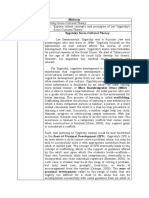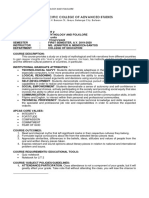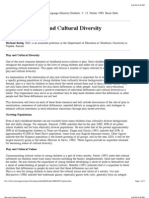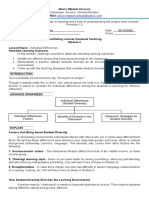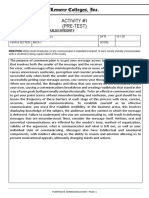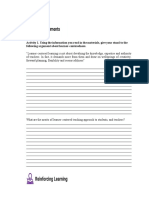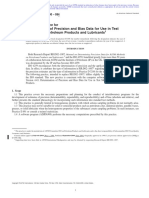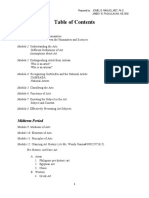Lesson 2: Teaching Speaking: Objectives
Uploaded by
maryrose condesLesson 2: Teaching Speaking: Objectives
Uploaded by
maryrose condesLesson 2: Teaching Speaking
Lesson 2:
TEACHING SPEAKING
INTRODUCTION
Among the four macro skills, speaking is regarded as the most basic and the
most essential. As a social being, man needs to communicate and interact with other
people. A person who knows a language is a speaker of that language. Being able to
express oneself in the target language gives one an edge over those who are incapable
of expressing themselves.
Learning to speak, however, is not simply about knowing the rules of grammar.
One must know what to say about something, how to say it, to whom, where, and
when to say it. Speaking requires a lot of exposures to varied situations in order to gain
the confidence and the proficiency to use language in order to function effectively in
society.
It is therefore important that adequate opportunities for practice be provided to
learners in order to develop their ability to express themselves competently using the
target language. As a prospective teacher in the elementary years of a child, you have
that great opportunity of laying the foundation for the development of competencies
for oral communication.
In this lesson, you will learn about salient concepts on teaching speaking and the
strategies you may employ to develop the speaking skills of your future learners.
Time Frame: 9 hours
Objectives
At the end of this lesson, you should be able to:
identify problems that hinder successful speaking activities and suggest ways to
remedy them;
use different strategies based on the principles of oral interaction skills in English.
Module in TECELA: Teaching English in the Elementary Grades (Language Arts) 20
Lesson 2: Teaching Speaking
Engage S2
Here is a list of statements with an “Agree-Disagree” continuum below each.
Put a cross on the continuum for each statement to indicate how far you agree or
disagree with it. Justify your answer.
1. Oral langauge is the foundation of early literacy development.
Very much agree Totally disagree
2. It is all right to correct a student’s error in grammar on the spot.
Very much agree Totally disagree
3. The most effective way to cultivate one’s skill in speaking is through pattern
practice.
Very much agree Totally disagree
4. Students can easily talk about a topic they are familiar with.
Very much agree Totally disagree
5. If a student cannot express himself/herself in the target language, the student
can always use the mother tongue.
Very much agree Totally disagree
Module in TECELA: Teaching English in the Elementary Grades (Language Arts) 21
Lesson 2: Teaching Speaking
Your stand on the statements given reflects your philosophy in language
teaching. Your belief will dictate the actions you shall take when
confronted with such situations in the classroom. Thus, it is important that you
equip yourself with the theories and principles in language learning to guide
your actions. Knowing the nature of the oral communication process and the
barriers that hinder effective communication will help you gain better
understanding on how to assist your future students in developing their oral
communication skills.
Explore S2
LLL
Let us check your understanding on some key concepts on oral communication. Identify
whether the statement is TRUE or FALSE. Write your answers on your Activity Notebook.
__________1. Failure in communication happens when themessage is not understood and
responded to as intended.
__________2. Motivation is high when learners are eager to speak because they are interested in
the topic and have something new to say about it.
__________3. Language is of an acceptable level when it is gramatically correct and pronunciation of
words is accurate.
__________4. Teachers should allow the students to use mother tongue so that they can express
themselves well during the discussion.
__________5. Students should be encouraged to use high level vocabulary during the discussion in
order to gain higher rating in oral performance.
__________6. Highly intereting topics and clear purpose of discussion can motivate students to
actively engage in the discussion.
__________7. Giving clear instructions on how to go about the activity is vital element in successful
speaking activities.
__________8. Students oftentimes complain that they can not think of anything to say due to lack
of vocabulary to talk on the topic.
Module in TECELA: Teaching English in the Elementary Grades (Language Arts) 22
Lesson 2: Teaching Speaking
Explain S2
1. How does oral communication take place?
2. What are the possible barriers that hinder effective communication?
3. What are the characteristics of a successful speaking activity?
4. What strategies can a teacher employ to help learners develop their oral
communication skills?
These questions will be answered by the study notes provided below. Read and
understand them well.
THE NATURE OF ORAL COMMUNICATION PROCESS
Communication employs both verbal and non-verbal media. Four essential
elements are needed for a speech act to take place: 1) the sender or source, 2) a
message, 3) a receiver, and 4) a response or feedback.
The sender or source is the speaker and the medium used to send the message
comes in varied forms such as song, story, poem, etc. The receiver responds to the
message using feedback. However, there are instances when communication is blocked
due to noise. There are two types of noise: psychological noise and physical noise.
Psychological noise emanates from the sender and/or the receiver of the message. It
affects how the sender expresses his message and how the receiver reacts to it.
Examples are a feeling of resentment towards the other person and lack of interest on
the part of the receiver. Physical noise, on the other hand, affects the intelligibility and
clarity of the message. A talking audience, background music, the honking of horns
from the passing vehicles and other sounds in the surrounding are examples of physical
noise.
BARRIERS TO EFFECTIVE COMMUNICATION
There are many factors that cause communication beakdown. Many of these
are language-related as follows:
Mispronunciations. Wrong pronunciation of a word can greatly affect the
meaning of the message and can lead to confusion.
Lack of awareness of the variety of English pronunciations of a given word.
Varieties of English have their own distinct pronunciations that can sometimes
lead to misunderstanding if one is not aware of how other countries utter
Module in TECELA: Teaching English in the Elementary Grades (Language Arts) 23
Lesson 2: Teaching Speaking
English words. This is because non-native speakers tend to nativized English
words and create a distinct variation of these words.
Different meanings attached to a word. A word may have a denotative
meaning and connotative meaning. Denotative meaning is the definition
provided in dictiionaries while connotative meaning is based on personal
meaning associated to a word.
Psychological factors. Our own emotions can affect delivery or reception of the
message. Our reactions to a message may be influenced by our opinion of and
feelings for the sender of the message. Moreover, the way we word our
messages is also conditioned by our feelings
Delivery of the message. Our manner of delivery such as the volume of one’s
voice and the rate of speaking may have an effect on the intelligibility and clarity
of the message.
Situation or setting. The condition of the place where you are in such as physical
noise, size of the room, and size of the audience may impede communication.
CHARACTERISTICS OF A SUCCESSFUL SPEAKING ACTIVITY
More learner talk. It is desired that a big part of the
period allotted to the activity is occupied by learner talk.
Even participation. Classroom discussion is participated in by everyone in the
class and is not monopolized by a minority of talkative students.
High motivation. Eagerness to participate is influenced by the interest of the
students in the topic and the opportunity to share new information or ideas
about it.
Acceptable language. Learners express themselves in utterances that are
relevant, easily comprehensible to each other, and of an aceptable level of
language accuracy.
In practice, however, satisfying all the criteria to have a successful
speaking activity is not easy. Getting learners to talk in class is a challenge at
times. The common problems with speaking activities are presented below.
Module in TECELA: Teaching English in the Elementary Grades (Language Arts) 24
Lesson 2: Teaching Speaking
PROBLEMS WITH SPEAKING ACTIVITIES
1. Inhibition. Unlike listening, writing, and listening, speaking demands certain degree
of real time exposure to an audience. Learners are not confident enough to speak in
a foreign language in front of an audience for fear of committing mistakes and of
being criticized or embarrassed.
2. Nothing to say. Learners often complain that they are not knowledgeable about a
certain topic, thus, they can not think of anything to say.
3. Low or uneven participation. Class discussions are sometimes dominated by some
learners that leave others with little time to share or not at all.
4. Mother-tongue use. Most learners tend to use the native language instead of the
target language due their lack of competence in speaking the language. They also
find it easier and feel more natural expressing themselves usiing their native tongue.
This, however, does not help the learner in gaining the skills in speaking the target
language.
What a teacher can do to help soive some of the problems:
Use group work. This increases the amount of learner talk in a limited period of
time and lowers learner inhibitions. Not all utterances said may be closely
monitored by the teacher for correctness and learners may occasionally shift to
the first language, but the amount of time for positive, useful oral practice is stil
likely to be more than in the whole class set up.
Base the activity on easy language. The level of language needed for discussion
should be lower than that used in intensive language learning activities. The
language should be easily recalled and produced by the learners so they can
speak fluently with minimum hesitation. It is advised that a review of essential
vocabulary be given before the activity starts.
Make a careful choice of topic and task to stimulate interest. The clearer the
purpose of the discussion the more motivated the learners will be.
Give some instruction or training in discussion skills. Clear instruction on how
to go about the activity should be given. A chairperson for each group should be
appointed to faciitate group interaction and to ensure that everyone contributes
to the discussion.
Keep students speaking the target language. A monitor for each group may be
assigned to remind the group participants to speak English.
Module in TECELA: Teaching English in the Elementary Grades (Language Arts) 25
Lesson 2: Teaching Speaking
To help the learners develop their oral proficiency skills, it is important
that the teacher provides sufficient opportunities to develop students’
confidence in the use of the English language. Your creativity and
resourcefulness in the utilization of oral communication strategies will
play a big role in conditioning the students to feel comfortable in using the English
language in their daily activities, both academic and personal in nature.
ORAL COMMUNICATION STRATEGIES
There are varied oral communication strategies that can be used by the teacher.
Some of these are as follows:
1. Discussion Describing pictures
Activities This is a simple but productive activity. Each group has a picture which all
members can see. They have two minutes to say as many sentences as they can
to describe it. A secretary marks a tick on a piece of paper representing each
Discussion
sentence. At the end of the two minutes, groups report how many ticks they
activities can take
have. they then repeat the exercise with the second picture, trying to get more
different forms
ticks than the first time.
dpending on what
is discussed and Picture Differences
the objective of Students are in pairs. Each has a different picture (either A or B). Without
the dscussion. Not showing the other his picture, a student tries to find out the difference between
only do they the two pictures. For example, he says, “The girl in your picture is short and fat,
provide but the one in my picture is tall and thin.”
meaningful Things in common
practice in the Students sit in pairs, choosing someone they do not know very well as their
language but they partner. They converse to find out things that they have in common. At the end,
also develop they share their findings with the whole class.
negotiation skills. Problem-solving activity
Students are presented with a situation which poses a problem to which they
meet to to fiind a solution.
Consensus-seeking activity
Students are given an important issue for discussion. They first state their own
views and stand on the issue. Then they try to convince each other to arrive at
just one stand on the matter.
Moral dilemma issues
Students are presented with a situation where they have to make a decision
based on their principles and values.
Humanistic activities
These are usually “getting-to-know each other better” activities with a dual
purpose: linguistic as well as affective. The former gives practice on the
grammar point/problem while the latter aims to establish a warm, supportive,
non-threatening cllimate in the classroom.
Module in TECELA: Teaching English in the Elementary Grades (Language Arts) 26
Lesson 2: Teaching Speaking
2. Language Relaying ad carrying out instructions
Games Students give each other instructions. The success of this activity depends on the
correct giving and interpreting of instructions.
Language games Story construction game
are generally This game is based on the principle of information gap. The students are divided
experiential, into groups and each group is given one picture to study. The groups are then
inviting students’ disbanded and onestudent per group is placed with representatives from the
attention to take other groups to form a new team. They describe the picture they saw in their
part in or to previous groups to come up with a story.
witness language Strip story
behavior and This is a variation of the story reconstruction game. First, the story is summarized
attitudes. by the teacher and written down on a piece of paper. The summary is then cut
up into strips with one sentence per strip. The strips are distributed to the
members of the group, one strip per student. The students are instructed to
memorize the sentence on their strips, share it with the group and together
reconstruct the story. it is in the negotiation that takes place during the task that
students use free spontaneous talk.
3. Student- Dyadic or Pair work
centered The students are asked to pair off and interact with each other as they carry out
interaction the task assigned to them.
modes Small groups discussions (SDG)
The students are divided in to groups and work as a group on a given task. The
smaller the size of the group, the better, the ideal size is 5 to 8 members to a
group.
4. Role play Dialogue
and related This is a traditional language-learning technique where students are taught a
techniques brief dialogue which they learn by heart.
Particularly for the beginners or the less confident, the dialogue is a good way to
get learners to practice saying target-language utterances without hesitation and
This refers to all within a wide variety of contexts.
sorts of activities
where learners Plays
imagine These are an expansion of the dialogue technique, where a class learns and
themselves in a performs a play. This can be based on something they have read or composed or
situation where an actual play from literature.
they play the role Rehearsals and other preparations may be time-consuming, but the results can
of someone else, contribute a great deal to learning and to the learners’ confidence.
and use language Simulation
appropriate to the In simulations, the individual participants speak and react as themselves, but the
new context. group role, situation, and task they are given is an imaginary one.
Role play
Students are given situation plus a problem or task, as in simulations, but they
are also allotted individual roles, written out on cards.
For example:
Role Card A: You are a customer in a bake shop. You want a birthday cake for a
friend. He or she is very fond of chocolate.
Factors that contribute to the succes of a role play are: making sure that the
language demanded is well within the learners’ capacity; participants’
enthusiasm; careful and clear presentation and instructions. A preliminary
demonstration or rehearsal by you together with a student volunteer can be very
helpful.
Module in TECELA: Teaching English in the Elementary Grades (Language Arts) 27
Lesson 2: Teaching Speaking
Elaborate S2
Applying the concepts you have learned in Explain 2-L, answer the following items
with True or False. If your answer is False, justify your answer in not more than five
sentences.
_______1. We use negotiation skills in oral communication.
_______2. Dialogues taught in class must be memorized by the students.
_______3. Too many play rehearsals before performance are time-consuming and
should be discouraged.
_______4. Role plays and other oral communication strategies enhance fluency in
the langauge.
_______5. Group members arrive at a consensus by having different opinions.
_______6. In a dyadic exchange, students pair off and interact with each other as
they carry out the task assigned to them.
_______7. The success of relaying and carrying out instructions depends on correct
giving and interpreting of instructions.
_______8. Use of group work can provide opportunities for more students to speak
up and practice using the target language.
_______9. Teachers should allow students to revert to the mother tongue to allow
them to have lively discussion when doing group work.
_______10. In a speaking activity, it is permissible for a teacher to allow some
students to dominate the discussion and let the rest of the class to listen.
Module in TECELA: Teaching English in the Elementary Grades (Language Arts) 28
Lesson 2: Teaching Speaking
Evaluate S2
Four problems have been identified in conducting speaking activities.
These are inhibition, nothing to say, low or uneven participation, and
mother-tongue use. What strategies can you employ to address each
problem? Choose from the suggested oral communication strategies
presented and discuss how these can be done. Use the matrix below.
Problem Strategy to address the Procedure
problem
1. Inhibition
2. Nothing to say
3. Low and uneven
participation
4. Mother-tongue use
Rubric for Rating
The identified The identified The identified The identified
strategy is strategy is strategy is strategy is not
appropriate to appropriate to appropriate to appropriate to
address the address the address the address the
problem. The problem. The problem. The problem
procedure given is procedure given procedure given is
clear and lacks some details. not clear and
Problem detailed. Use of There are some contains significant
language is free errors in grammar errors in grammar
from errors in and writing and writing
grammar and mechanics. mechanics that
mechanics in affect intelligibility.
writing.
3 2 1 0
1. Inhibition 3 2 1 0
2. Nothing to say 3 2 1 0
3.Low or uneven 3 2 1 0
participation
4. Use of Mother tongue 3 2 1 0
Total Score
Module in TECELA: Teaching English in the Elementary Grades (Language Arts) 29
Lesson 2: Teaching Speaking
Scoring Guide:
12 – 100 9 – 88 6 – 75 3 - 63
11 – 95 8 – 83 5 – 71 2 - 58
10 – 92 7 – 79 4 – 67 1 – 54
Assignment: On-line Safari
Search the internet and look for at least 10 fun and engaging activities that may be
employed to develop oral fluency among students. Describe the “what and the how” of
the chosen activities. Cite your references.
Rubric for Rating the assignment
Relevance & Very high High Moderate Low Very low
practicality 5 pts 4 pts 3 pts 2 pts 1 pt
Appeal to Very high High Moderate Low Very low
Students 5 pts 4 pts 3 pts 2 pts 1 pt
Completeness of 100 % 90% 80% 70% 60%-below
data 5 pts 4 pts 3 pts 2 pts 1 pt
Punctuality Submitted on or Submitted on Submitted on Submitted on Submitted on
before Sept. 7, 2020 Sept. 8, 2020 Sept. 9, 2020 Sept. 10,
Sept. 4, 2020 2020
5 pts 4 pts 3 pts 2 pts 1 pt
Module in TECELA: Teaching English in the Elementary Grades (Language Arts) 30
You might also like
- Lesson 1: Teaching Listening: Time Frame: 9 Hours100% (1)Lesson 1: Teaching Listening: Time Frame: 9 Hours11 pages
- Facilitating Learner Centered Teaching MidtermNo ratings yetFacilitating Learner Centered Teaching Midterm18 pages
- Gordon College: College of Education, Arts and SciencesNo ratings yetGordon College: College of Education, Arts and Sciences7 pages
- PE 3 - The Teacher and The Community, School Culture and Organizational Leadership100% (1)PE 3 - The Teacher and The Community, School Culture and Organizational Leadership141 pages
- Course No.: Ed 105 Descriptive Title: Facilitating Learning: CHAPTER I - MetacognitionNo ratings yetCourse No.: Ed 105 Descriptive Title: Facilitating Learning: CHAPTER I - Metacognition17 pages
- Approaches, Strategies & Methods of TeachingNo ratings yetApproaches, Strategies & Methods of Teaching4 pages
- GROUP 2 The Structure of The K To 12 Language Arts Curriculum 2100% (1)GROUP 2 The Structure of The K To 12 Language Arts Curriculum 225 pages
- Microsoft Word 2010 Easter Egg Hunt Flyer TutorialNo ratings yetMicrosoft Word 2010 Easter Egg Hunt Flyer Tutorial33 pages
- Week 6: Ms. Thelma G. Baloran, Maed InstructorNo ratings yetWeek 6: Ms. Thelma G. Baloran, Maed Instructor8 pages
- SEM 111 Weeks13-14 Language Learning Material Development (20230426095827)No ratings yetSEM 111 Weeks13-14 Language Learning Material Development (20230426095827)17 pages
- Learner-Centered Psychological Principles (LCP)No ratings yetLearner-Centered Psychological Principles (LCP)24 pages
- Lecture Guide Remedial Instruction in English 1100% (1)Lecture Guide Remedial Instruction in English 122 pages
- Section 1.the Professional Teachers Are Socially Responsible Chapter 1. Socially Responsible Teachers: Rich With Professional HeritageNo ratings yetSection 1.the Professional Teachers Are Socially Responsible Chapter 1. Socially Responsible Teachers: Rich With Professional Heritage5 pages
- Communication Processes Principles and Ethics100% (1)Communication Processes Principles and Ethics41 pages
- Students Who Are Blind or Have Low VisionNo ratings yetStudents Who Are Blind or Have Low Vision26 pages
- Robert Gagné's Instructional Design ApproachNo ratings yetRobert Gagné's Instructional Design Approach15 pages
- I Am Sharing 'Purposive-Communication-Lesson-1-Activities' With YouNo ratings yetI Am Sharing 'Purposive-Communication-Lesson-1-Activities' With You2 pages
- Activity 1. Using The Information You Read in The Materials, Give Your Stand To The Following Argument About Learner-CenterednessNo ratings yetActivity 1. Using The Information You Read in The Materials, Give Your Stand To The Following Argument About Learner-Centeredness6 pages
- Don Carlos Polytechnic College: Republic of The Philippines Province of Bukidnon Municipality of Don Carlos100% (1)Don Carlos Polytechnic College: Republic of The Philippines Province of Bukidnon Municipality of Don Carlos9 pages
- Introduction To Effective Oral CommunicationNo ratings yetIntroduction To Effective Oral Communication30 pages
- Introduction To Curriculum Development Lesson 1No ratings yetIntroduction To Curriculum Development Lesson 188 pages
- University of Southeastern Philippines: Course Syllabus in Introduction To LinguisticsNo ratings yetUniversity of Southeastern Philippines: Course Syllabus in Introduction To Linguistics5 pages
- Oral Communication in the Disciplines: A Resource for Teacher Development and TrainingFrom EverandOral Communication in the Disciplines: A Resource for Teacher Development and TrainingNo ratings yet
- Lesson 5: Teaching Viewing: Time Frame: One Week 9 Hours100% (4)Lesson 5: Teaching Viewing: Time Frame: One Week 9 Hours13 pages
- Alijis Campus - Binalbagan Campus - Fortune Towne Campus - Talisay Campus100% (1)Alijis Campus - Binalbagan Campus - Fortune Towne Campus - Talisay Campus8 pages
- Anterior Cross Bites in Primary Mixed Dentition PedoNo ratings yetAnterior Cross Bites in Primary Mixed Dentition Pedo32 pages
- Simple Past Tense Grammar Drills Grammar Guides - 1928No ratings yetSimple Past Tense Grammar Drills Grammar Guides - 192810 pages
- Corina V Makore Final Dissertation PDF DocumentNo ratings yetCorina V Makore Final Dissertation PDF Document81 pages
- Auditing Operating Systems Networks: Security Part 1: andNo ratings yetAuditing Operating Systems Networks: Security Part 1: and24 pages
- Determination of Precision and Bias Data For Use in Test Methods For Petroleum Products and LubricantsNo ratings yetDetermination of Precision and Bias Data For Use in Test Methods For Petroleum Products and Lubricants34 pages
- Industrial Employment (Standing Orders) Act, 1946100% (1)Industrial Employment (Standing Orders) Act, 194624 pages
- Download Complete (Ebook) Rapid Quantitative Aptitude - With Shortcuts & Tricks for Competitive Exams by Deepak Agarwal; D.P. Gupta PDF for All Chapters100% (4)Download Complete (Ebook) Rapid Quantitative Aptitude - With Shortcuts & Tricks for Competitive Exams by Deepak Agarwal; D.P. Gupta PDF for All Chapters67 pages
- Coal Sampling Slide Show Without PhotosNo ratings yetCoal Sampling Slide Show Without Photos94 pages
- 22CS 1st Semester Tabulation Sheet May 2023No ratings yet22CS 1st Semester Tabulation Sheet May 202312 pages
- Module in Art Appreciationdocx PDF Free PDF100% (1)Module in Art Appreciationdocx PDF Free PDF54 pages
- Gordon College: College of Education, Arts and SciencesGordon College: College of Education, Arts and Sciences
- PE 3 - The Teacher and The Community, School Culture and Organizational LeadershipPE 3 - The Teacher and The Community, School Culture and Organizational Leadership
- Course No.: Ed 105 Descriptive Title: Facilitating Learning: CHAPTER I - MetacognitionCourse No.: Ed 105 Descriptive Title: Facilitating Learning: CHAPTER I - Metacognition
- GROUP 2 The Structure of The K To 12 Language Arts Curriculum 2GROUP 2 The Structure of The K To 12 Language Arts Curriculum 2
- Microsoft Word 2010 Easter Egg Hunt Flyer TutorialMicrosoft Word 2010 Easter Egg Hunt Flyer Tutorial
- SEM 111 Weeks13-14 Language Learning Material Development (20230426095827)SEM 111 Weeks13-14 Language Learning Material Development (20230426095827)
- Section 1.the Professional Teachers Are Socially Responsible Chapter 1. Socially Responsible Teachers: Rich With Professional HeritageSection 1.the Professional Teachers Are Socially Responsible Chapter 1. Socially Responsible Teachers: Rich With Professional Heritage
- I Am Sharing 'Purposive-Communication-Lesson-1-Activities' With YouI Am Sharing 'Purposive-Communication-Lesson-1-Activities' With You
- Activity 1. Using The Information You Read in The Materials, Give Your Stand To The Following Argument About Learner-CenterednessActivity 1. Using The Information You Read in The Materials, Give Your Stand To The Following Argument About Learner-Centeredness
- Don Carlos Polytechnic College: Republic of The Philippines Province of Bukidnon Municipality of Don CarlosDon Carlos Polytechnic College: Republic of The Philippines Province of Bukidnon Municipality of Don Carlos
- University of Southeastern Philippines: Course Syllabus in Introduction To LinguisticsUniversity of Southeastern Philippines: Course Syllabus in Introduction To Linguistics
- Oral Communication in the Disciplines: A Resource for Teacher Development and TrainingFrom EverandOral Communication in the Disciplines: A Resource for Teacher Development and Training
- Lesson 5: Teaching Viewing: Time Frame: One Week 9 HoursLesson 5: Teaching Viewing: Time Frame: One Week 9 Hours
- Alijis Campus - Binalbagan Campus - Fortune Towne Campus - Talisay CampusAlijis Campus - Binalbagan Campus - Fortune Towne Campus - Talisay Campus
- Anterior Cross Bites in Primary Mixed Dentition PedoAnterior Cross Bites in Primary Mixed Dentition Pedo
- Simple Past Tense Grammar Drills Grammar Guides - 1928Simple Past Tense Grammar Drills Grammar Guides - 1928
- Auditing Operating Systems Networks: Security Part 1: andAuditing Operating Systems Networks: Security Part 1: and
- Determination of Precision and Bias Data For Use in Test Methods For Petroleum Products and LubricantsDetermination of Precision and Bias Data For Use in Test Methods For Petroleum Products and Lubricants
- Download Complete (Ebook) Rapid Quantitative Aptitude - With Shortcuts & Tricks for Competitive Exams by Deepak Agarwal; D.P. Gupta PDF for All ChaptersDownload Complete (Ebook) Rapid Quantitative Aptitude - With Shortcuts & Tricks for Competitive Exams by Deepak Agarwal; D.P. Gupta PDF for All Chapters


